Related Research Articles

The Northrop Grumman RQ-4 Global Hawk is a high-altitude, remotely-piloted surveillance aircraft introduced in 2001. It was initially designed by Ryan Aeronautical, and known as Tier II+ during development. The RQ-4 provides a broad overview and systematic surveillance using high-resolution synthetic aperture radar (SAR) and electro-optical/infrared (EO/IR) sensors with long loiter times over target areas.

The Northrop Grumman MQ-4C Triton is an American high-altitude long endurance unmanned aerial vehicle (UAV) developed for and flown by the United States Navy as a surveillance aircraft. Together with its associated ground control station, it is an unmanned aircraft system (UAS). Developed under the Broad Area Maritime Surveillance (BAMS) program, the Triton is intended to provide real-time intelligence, surveillance and reconnaissance missions (ISR) over vast ocean and coastal regions, continuous maritime surveillance, conduct search and rescue missions, and to complement the Boeing P-8 Poseidon maritime patrol aircraft.

The Beechcraft T-34 Mentor is an American propeller-driven, single-engined, military trainer aircraft derived from the Beechcraft Model 35 Bonanza. The earlier versions of the T-34, dating from around the late 1940s to the 1950s, were piston-engined. These were eventually succeeded by the upgraded T-34C Turbo-Mentor, powered by a turboprop engine. The T-34 remains in service more than seven decades after it was first designed.

Pacific Missile Test Center (PMTC) is the former name of the current Naval Air Warfare Center, Weapons Division. The name of the center was the Naval Air Missile Test Center prior to PMTC. It is located at Naval Base Ventura County/Naval Air Station Point Mugu in Ventura County, California. The nearest city to the installation is Oxnard.
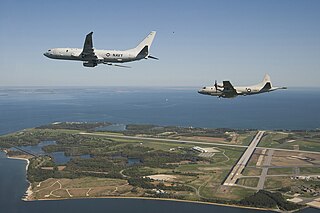
Naval Air Station Patuxent River, also known as NAS Pax River, is a United States naval air station located in St. Mary’s County, Maryland, on the Chesapeake Bay near the mouth of the Patuxent River.

The AN/SPN-46(V)1 is a Precision Approach and Landing System, manufactured in the United States, by Textron Systems, which is used on aircraft carriers of the United States Navy. The radar uses two dual-band radar antennas, which also function as transmitters, to guide planes or helicopters to the ship.
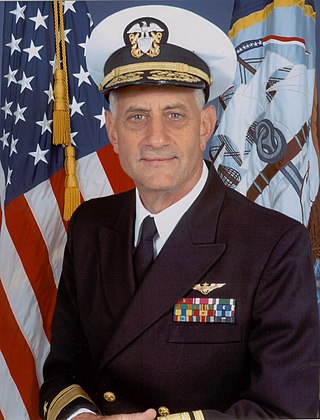
Rear Admiral Charles Herbert Johnston Jr., United States Navy, was appointed Vice Commander of the Naval Air Systems Command, (NAVAIR) at NAS Patuxent River, Maryland in December 2001.

The Naval Air Systems Command (NAVAIR) provides materiel support for aircraft and airborne weapon systems for the United States Navy. It is one of the Echelon II Navy systems commands (SYSCOM), and was established in 1966 as the successor to the Navy's Bureau of Naval Weapons.
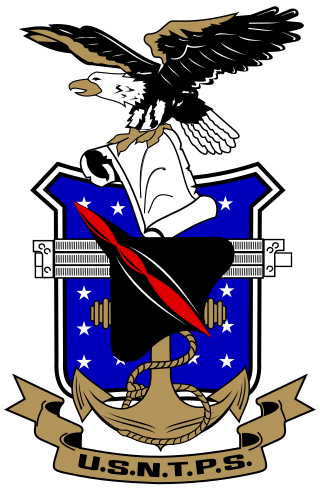
The United States Naval Test Pilot School (USNTPS), located at Naval Air Station (NAS) Patuxent River in Patuxent River, Maryland, provides instruction to experienced United States Navy, Marine Corps, Army, Air Force, and foreign military experimental test pilots, flight test engineers, and flight test flight officers in the processes and techniques of aircraft and systems testing and evaluation.
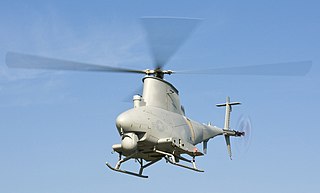
The Northrop Grumman MQ-8 Fire Scout is an unmanned autonomous helicopter developed by Northrop Grumman for use by the United States Armed Forces. The Fire Scout is designed to provide reconnaissance, situational awareness, aerial fire support and precision targeting support for ground, air and sea forces. The initial RQ-8A version was based on the Schweizer 330, while the enhanced MQ-8B was derived from the Schweizer 333. The larger MQ-8C Fire Scout variant is based on the Bell 407.
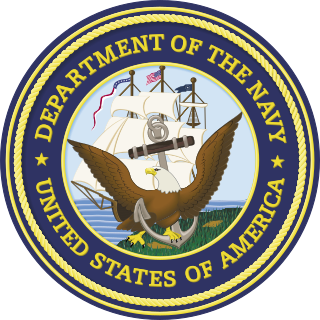
The Naval Air Warfare Center Training Systems Division (NAWCTSD) is an Echelon IV command of the United States Navy, reporting to the Commander, Naval Air Warfare Center - Aircraft Division (NAWCAD) at NAS Patuxent River, Maryland. NAWCTSD is located in Orlando, Florida in the Central Florida Research Park, adjacent to the University of Central Florida (UCF). The facility is a part of a larger military installation within the Central Florida Research Park known as Naval Support Activity Orlando.

Air Test and Evaluation Squadron 23 (VX-23) is an aviation unit of the United States Navy based at Naval Air Station Patuxent River, Maryland, United States. The squadron was established on 22 July 1995. Using the tail code SD, the squadron operates multiple aircraft types of the United States Navy for test and evaluation purposes.

The United States Marine Corps Aviation (USMCA) is the aircraft arm of the United States Marine Corps. Aviation units within the Marine Corps are assigned to support the Marine Air-Ground Task Force, as the aviation combat element, by providing six functions: assault support, antiair warfare, close air support, electronic warfare, control of aircraft and missiles, and aerial reconnaissance. The Corps operates rotary-wing, tiltrotor, and fixed-wing aircraft mainly to provide transport and close air support to its ground forces. Other aircraft types are also used in a variety of support and special-purpose roles. All Marine Corps aviation falls under the influence of the Deputy Commandant for Aviation, whose job is to advise the Commandant of the Marine Corps in all matters relating to aviation, especially acquisition of new assets, conversions of current aircraft, maintenance, operation, and command.

The Operational Test and Evaluation Force (OPTEVFOR) is an independent and objective agency within the United States Navy for the operational testing and evaluation (OT&E) of naval aviation, surface warfare, submarine warfare, C4I, cryptologic, and space systems in support Navy and Department of Defense acquisition programs.

VX-20, Air Test and Evaluation Squadron Twenty, is a United States Navy air test and evaluation squadron based at Naval Air Station Patuxent River, Maryland.

Air Test and Evaluation Squadron TWO ONE (HX-21) "Blackjack" is a U.S. Navy aircraft squadron located at Naval Air Station Patuxent River, Maryland on the Chesapeake Bay. As part of the Naval Air Warfare Center Aircraft Division (NAWC-AD), Naval Test Wing Atlantic (NTWL), HX-21 is responsible for the Developmental Test and Evaluation of Navy and Marine Corps rotary-wing/tilt-rotor aircraft, airborne systems, and Unmanned Aircraft Systems (UAS) in support of acquisition decisions that improve the Navy and Marine Corps' war fighting capability. Additionally, HX-21 tests and evaluates new mission systems to integrate legacy aircraft into the constantly evolving fighting force.

Air Test and Evaluation Squadron 30, nicknamed The Bloodhounds) is a United States Navy air test and evaluation squadron based at Naval Air Station Point Mugu, California. Using the tail code BH, the squadron flies the E-2D Hawkeye, Lockheed P-3 Orion, Gulfstream NC-20G, and the Lockheed C-130 Hercules aircraft. The VX-30 Bloodhounds provide support to the United States Navy's Sea Test Range off the shores of central California.

The Boeing Insitu RQ-21 Blackjack, company name Integrator, is an American unmanned air vehicle designed and built by Boeing Insitu to meet a United States Navy requirement for a small tactical unmanned air system (STUAS). It is a twin-boom, single-engine monoplane, designed as a supplement to the Boeing Scan Eagle. The Integrator weighs 61 kg (134 lb) and uses the same launcher and recovery system as the Scan Eagle.
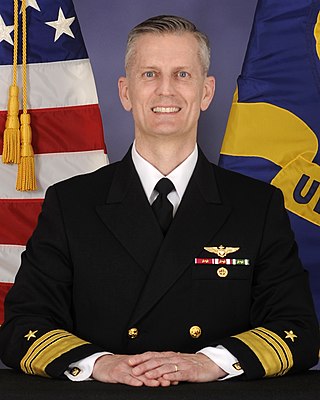
Gordon Dean Peters is a retired United States Navy vice admiral who last served as the commander of the Naval Air Systems Command from May 31, 2018 to September 9, 2021. He previously served as the Program Executive Officer for Air Anti-Submarine Warfare, Assault, and Special Mission Programs of the United States Navy. Peters graduated from the United States Naval Academy in 1985 and was designated a naval aviator in 1986. He earned a Master of Science degree in aeronautical engineering from the Naval Postgraduate School in 1992. Peters also holds a post-graduate degree in telecommunications and has graduated from the Naval Test Pilot School.
References
- ↑ "About Us". www.navair.navy.mil. Archived from the original on 2016-04-11.
- ↑ "Welcome to the Naval Air Warfare Center - Aircraft Division | www.navair.navy.mil/nawcad". www.navair.navy.mil. Archived from the original on 2009-07-21.
- ↑ "Naval Air Warfare Center Aircraft Division (NAWCAD)". www.cnic.navy.mil. Retrieved 2019-07-09.
- ↑ "AOPA Airports". www.aopa.org. Retrieved 2019-07-09.
- ↑ "Naval Air Warfare Center (NAWC) - Aircraft Division - Patuxent River | Federal Labs". www.federallabs.org. Retrieved 2019-07-10.
- ↑ "Naval Air Station Patuxent River". www.cnic.navy.mil. Retrieved 2019-07-09.
- ↑ "About Us". St. Mary's County Chamber of Commerce. Retrieved 2019-07-09.
- ↑ "Naval Air Warfare Center Weapons Division". www.cnic.navy.mil. Retrieved 2019-07-09.
- ↑ "Naval Air Warfare Center – Aircraft Division | TechLink". TechLink Center. Retrieved 2019-07-10.
- ↑ "Naval Air Systems Command (NAVAIR)". www.cnic.navy.mil. Retrieved 2019-07-09.
- ↑ "Naval Test Wing Atlantic | NAWCAD". www.navair.navy.mil. Retrieved 2019-07-10.
- ↑ "Naval Aircraft Testing Likely Caused Sonic Booms". ABC News. Retrieved 2019-07-09.
- ↑ Affairs, This story was written by Naval Air Warfare Center Aircraft Division Public. "U.S. Navy Holds Ceremony to mark First Dedicated UAS Test Squadron". www.navy.mil. Retrieved 2019-07-09.
- ↑ "United States Naval Test Pilot School | NAWCAD". www.navair.navy.mil. Retrieved 2019-07-10.
- ↑ "Naval Test Pilot School Adds New Focus on Unmanned Aircraft". USNI News. 2019-06-27. Retrieved 2019-07-09.
- ↑ Mars, Kelli (2018-09-28). "NASA's Twins Study Results Published in Science Journal". NASA. Retrieved 2019-07-09.
- ↑ U.S. Navy. "ATLANTIC TEST RANGES : MARYLAND WITH NAS PATUXENT RIVER" (PDF). Readiness and Environmental Protection and Integration [REPI] Program Project Profile.
- ↑ "Atlantic Test Ranges | NAWCAD". www.navair.navy.mil. Retrieved 2019-07-10.